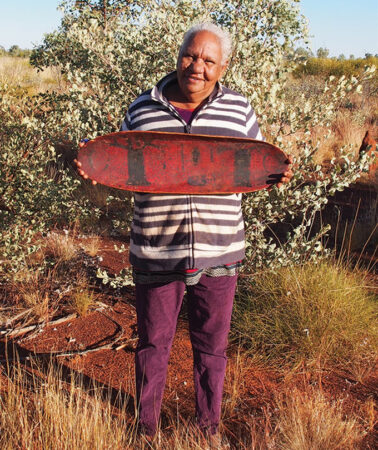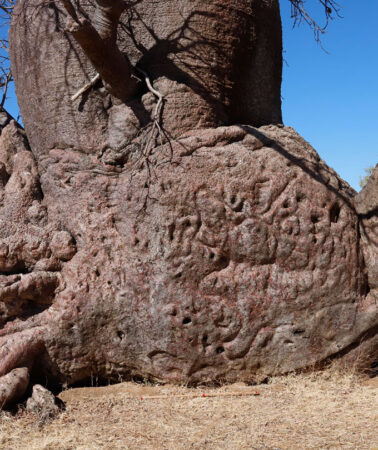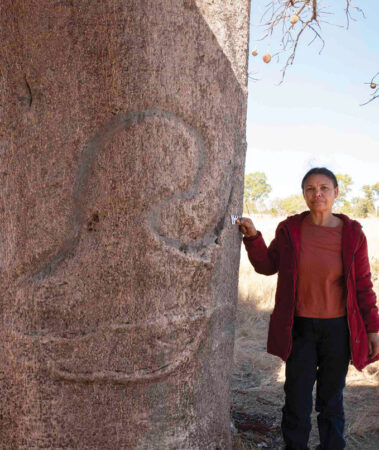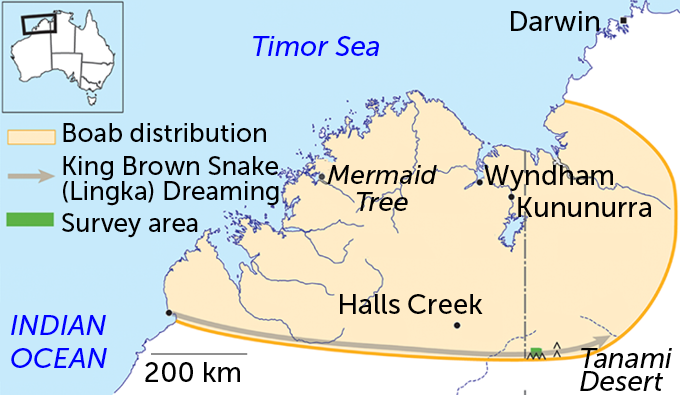This post was originally published on this site
Brenda Garstone is on the hunt for her heritage.
Parts of her cultural inheritance are scattered across the Tanami desert in northwestern Australia, where dozens of ancient boab trees are engraved with Aboriginal designs. These tree carvings — called dendroglyphs — could be hundreds or even thousands of years old, yet have received almost no attention from western researchers.
That is slowly starting to change. In the winter of 2021, Garstone — who is Jaru, an Aboriginal group from the Kimberley region of northwestern Australia — teamed up with archaeologists to find and document some of these carvings.
For Garstone, the expedition was a bid to piece back together the disparate parts of her identity. These pieces were scattered 70 years ago when Garstone’s mother and three siblings were among the estimated 100,000 Aboriginal children taken from their families by the Australian government. Like many others, the siblings were sent to live at a Christian mission thousands of kilometers from home. It would take decades of effort and a series of unconnected events — including the gift of an heirloom and a researcher’s quest to find out what happened to a missing 19th century European naturalist — for Garstone’s family to reclaim its birthright.

When the siblings returned to their mother’s homeland as teenagers, their extended family gave Garstone’s aunt, Anne Rivers, a coolamon, a type of shallow dish, decorated with two bottle trees, or boabs. Rivers, who was only 2 months old when she was sent away, was told that the trees were a part of her mother’s Dreaming, the cultural story that connected her and her family to the land.
Now, in a study published October 11 in Antiquity, researchers have meticulously described 12 boabs with dendroglyphs in the Tanami desert that have links to Jaru culture. And just in time: The clock is ticking for these ancient engravings as their host trees succumb to the ravages of time and growing pressure from livestock and possibly climate change.
The race to document these engravings before it’s too late isn’t just a matter of studying an ancient art form. It’s also a matter of healing the wounds inflicted by policies intended to erase the connection between Garstone’s family and the land.
“To find evidence that ties us to the land has been amazing,” she says. “The puzzle we’ve been trying to piece together is now complete.”
An outback archive
Australian boabs (Adansonia gregorii) proved pivotal to this project. Found in the northwestern corner of Australia, boabs are a species of tree easily recognizable by their massive trunks and iconic bottle shape.
Anthropologists have written about the existence of trees carved with Aboriginal symbols in Australia since the early 1900s. These records indicate that people were continuously carving and recarving some trees until at least the 1960s. But compared with other forms of Aboriginal art — such as the visually spectacular paintings also found in the area (SN: 2/5/20) — “there does not appear to be a wide general awareness of this art form,” says Moya Smith, curator of anthropology and archaeology at the Western Australia Museum in Perth, who was not involved with the study.
Darrell Lewis has come across his share of carved boabs. The historian and archaeologist now at the University of New England in Adelaide has worked in the Northern Territory for half a century. Lewis has spotted engravings made by cattle drovers, World War II soldiers and Aboriginal peoples. He calls this eclectic bag of engravings “the outback archive” — a physical testament to the people who have made this rugged part of Australia their home.
In 2008, Lewis was searching the Tanami Desert for what he hoped would be his biggest addition to the archive. He’d heard rumors that a cattle drover working in the area a century earlier had found a firearm stashed in a boab marked with the letter “L.” A roughly cast brass plate from the firearm — later bought by the National Museum of Australia — was stamped with the name of the famed German naturalist Ludwig Leichhardt, who disappeared in 1848 while traveling across western Australia.
The Tanami is generally considered to be outside the boab’s natural range. So in 2007, Lewis rented a helicopter and crisscrossed the desert in search of the Tanami’s secret stash of boabs. His flyovers revealed roughly 280 centuries-old boabs and hundreds of younger trees scattered across the desert.
“Nobody, not even locals, really knew there were any boabs out there,” he recalls.
His 2008 ground expedition to find the elusive “L” came up empty-handed. But the search did uncover dozens of boabs marked with dendroglyphs.
In a report for the National Museum of Australia, which had hired him to search for the “L” carving, Lewis recorded the location of these trees. That information sat untouched for years until one day, it fell into the hands of Sue O’Connor, an archaeologist at Australian National University in Canberra.
Crumble into dust
In 2018, O’Connor was part of a group of archaeologists who were growing increasingly concerned about the survival of boabs. That year, scientists studying baobabs in Africa — a close relative of boabs — noticed that some of the older trees were dying out at a surprisingly high rate, potentially due to climate change (SN: 6/18/18).
The news alarmed O’Connor. Dendroglyphs are often engraved on the largest and oldest boabs. While nobody knowns exactly how old these trees can get, researchers suspect that their lifetimes could be comparable to their African cousins, which can live up to 2,000 years.
When these long-lived trees do die, they pull a disappearing act. Unlike other trees, whose wood can be preserved for hundreds of years after death, boabs have a moist and fibrous interior that can quickly disintegrate. Lewis has witnessed boabs crumble into the dust a couple of years after being struck by lightning.
“You would never know there’d been a tree there,” he says.
Whether Australian boabs are threatened by climate change is unclear. But the trees are coming under attack from livestock, which peel back boabs’ bark to get to the wet interior. “We put all this together and thought we better try and locate some of the carvings because they probably won’t be there in a few years,” says O’Connor.
Lewis’ report provided a good jumping-off point for this work. So O’Connor reached out to the historian and suggested they collaborate.
Around that same time, Garstone was four years into her own research into her family’s heritage. The long and meandering search led her to a small museum that a friend of Lewis’ happened to run. When Garstone mentioned she was from Halls Creek — a town near where Lewis did his fieldwork in 2008 — the curator told her about the carved boabs.
“I was like, ‘What? That’s a part of our Dreaming!’” she recalls.

Dreamings are a western term used to refer to the vast diversity of stories that — among other things — recount how spiritual beings formed the landscape. Dreaming stories also pass down knowledge and inform rules of behavior and social interaction.
Garstone knew from the oral history passed down through her family that her grandmother had ties to the Bottle Tree Dreaming, as indicated by the trees painted on her aunt’s coolamon. The Bottle Tree Dreaming is one of the eastern-most manifestations of the Lingka Dreaming track (Lingka is the Jaru word for the King Brown Snake). This path runs for thousands of kilometers from the western coast of Australia and into the neighboring Northern Territory, marking Lingka’s journey across the landscape and forming a byway for people to travel across the country.
Eager to confirm that the boabs were a part of this Dreaming, Garstone, along with her mother, aunt and a scattering of other family members, joined the archaeologists on their mission to rediscover the boabs.
Into the Tanami
On a winter day in 2021, the group set out from the town of Halls Creek and set up camp on a remote pastoral station mainly populated by cattle and feral camels. Every day, the team climbed into all-wheel-drive vehicles and headed out to the last known location of the engraved boabs.
It was hard work. The crew often drove hours to the supposed position of a boab, only to have to stand on top of the vehicles and scan for trees in the distance. What’s more, wooden stakes sticking out of the ground constantly shredded the vehicles’ tires. “We were out there for eight or 10 days,” says O’Connor. “It felt longer.”
The expedition was cut short when they ran out of tires — but not before finding 12 trees with dendroglyphs. To document the finds, the archaeologists took thousands of overlapping pictures, capturing an image of every centimeter of each tree.

The team also spotted grinding stones and other tools scattered around the base of the trees. Considering that large boabs provide shade in a desert with little cover, the prevalence of these objects suggests that people probably used the trees as resting spots as well as navigational markers while traveling across the desert, the researchers report in their study.
Some of the carvings on the boabs were of emu and kangaroo tracks. But an overwhelming majority of the engravings were of snakes, some of which undulated across the bark while others coiled onto themselves. The knowledge provided by Garstone and her family, along with historical records from the area, points toward the carvings being linked to the King Brown Snake Dreaming.
“It was surreal,” Garstone says. Seeing the dendroglyphs confirmed the stories passed down in her family and is “pure evidence” of the ancestral connection to country, she says. The rediscovery has been healing, especially for her mother and aunt, both now in their 70s. “All of this was nearly lost because they didn’t grow up in their homeland with their families,” she says.
Maintaining the connection
The work to find and document carved boabs in the Tanami and in other parts of the country has just begun. But this initial foray reveals the “vital importance” of scientists working in collaboration with First Nations knowledge holders, says Smith.
O’Connor is organizing another expedition to find the rest of the engravings that Lewis spotted, though she intends to take better wheels or — ideally — a helicopter. Garstone is planning on coming along with more of her extended family in tow.
In the meantime, O’Connor says that their work appears to have stimulated interest among researchers and other Aboriginal groups to rediscover the lost art form and preserve it for future generations.
“Our connection to country is so important to maintain because it makes us who we are as First Nations people,” adds Garstone. “To know that we have a rich cultural heritage and to have our own museum in the bush is something we will treasure forever.”

